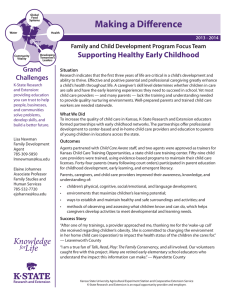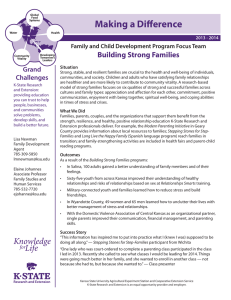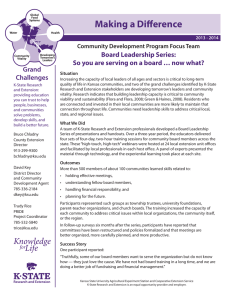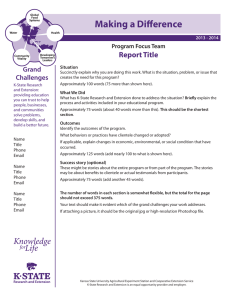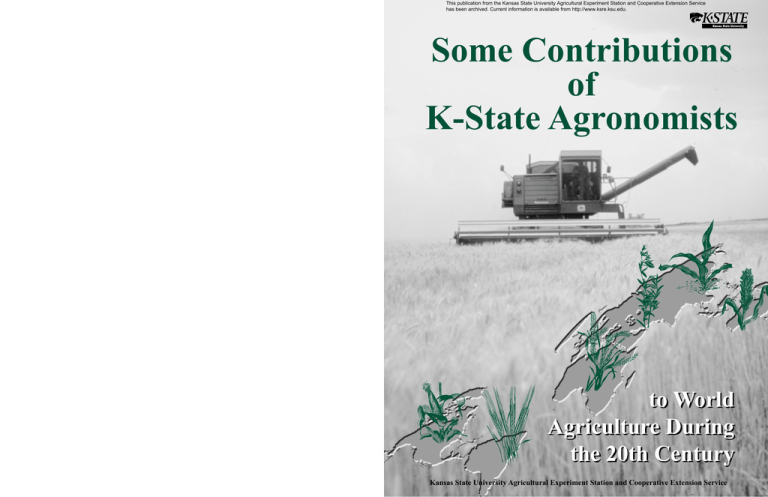
This publication from the Kansas State University Agricultural Experiment Station and Cooperative Extension Service
has been archived. Current information is available from http://www.ksre.ksu.edu.
Some Contributions
of
K-State Agronomists
to World
Agriculture During
the 20th Century
Kansas State University Agricultural Experiment Station and Cooperative Extension Service
This publication from the Kansas State University Agricultural Experiment Station and Cooperative Extension Service
has been archived. Current information is available from http://www.ksre.ksu.edu.
SOME CONTRIBUTIONS OF K-STATE
AGRONOMISTS TO WORLD AGRICULTURE
DURING THE 20TH CENTURY
Gary M. Paulsen*
Introduction
Agriculture in Kansas and the world advanced rapidly during the past century. Revolutions in crops and the technology for producing them raised yields three- or four-fold or
more and markedly improved the lives of billions of persons. Kansas became the “Wheat
State,” producing more of this major food grain in the U.S. than any other state. Feed
grains produced in the state support the second-largest beef industry in the U.S. In other
parts of the world, nearly three times as many persons have ample food in 2000 as in
1900 instead of suffering from the famines that were widely predicted.
Kansas State University alumni and faculty contributed significantly to many of the
important advances in crops during the 20th Century. They introduced wheats that started
a new grain industry in the U.S. and a Green Revolution in developing countries. They
made hybrid corn a practical crop, developed sorghum into a new feed grain, created a
“Miracle Rice” for Asia, and led overseas programs that became models for introducing
new technology to developing countries. In one way or another, their work impacted
most of the major crops grown in the U.S. and around the world.
Kansas agriculture benefitted directly from these advances along with the rest of the
world. Most varieties of wheat in the state contain the semi-dwarf genes that were basic
to the Green Revolution. Hybrid corn and combine-height sorghum produced in Kansas
support the large livestock industry in the state. Improved livelihoods of persons overseas
make them better customers for all of the state’s agricultural products.
Many more K-Staters than can be described here made important contributions to
world agriculture during the past century. Other persons would have different lists of
distinguished achievements. This roster, which was intended to illustrate the significance
and scope of contributions, is solely the responsibility of the author.
Most of the K-Staters who helped to shape crop agriculture as we know it today
were faculty or students in the Department of Agronomy. Some of their important
achievements were made at K-State, and others were made during their careers at other
institutions. In all cases, however, their contributions were instrumental in advancing the
science and technology of crops during the past century. This presentation is the story of
their remarkable contributions.
1
This publication from the Kansas State University Agricultural Experiment Station and Cooperative Extension Service
has been archived. Current information is available from http://www.ksre.ksu.edu.
Introducing New Wheats and a New Industry
Mark A. Carleton (1866-1925) shaped the hard red winter
wheat industry in the Great Plains by introducing hardy varieties and developing suitable systems of dryland farming. He also
introduced varieties that started the durum wheat industry in the
Northern Great Plains and several important oat varieties.
Carleton was born in Ohio and raised in Cloud County,
Kansas. He became a professor at Garfield University (now
Friends University) in Wichita after earning the B.S. degree.
After returning to K-State for an M.S. degree, he studied rust
diseases of cereals. Carleton then transferred to the USDA,
where he established the physiological relationship of nearly all
of the cereal rusts in the U.S. and became Chief of Cereal Investigations.
The U.S. Secretary of Agriculture sent Carleton to Russia
and Siberia as an agricultural explorer to collect rust-resistant
Mark A. Carleton
and
drought-resistant varieties of cereals in 1898 and 1899. He
B.S. K-State 1887
returned with ‘Kharkof,’ a winter-hardy type of ‘Turkey’ hard red
M.S. (agriculture)
K-State 1893
winter wheat that eventually occupied half of the Kansas wheat
Assistant Professor
area and dominated production in Nebraska and other states,
K-State 1893-94
and ‘Crimean,’ which became a parent of the first K-State varieties, ‘Kanred’ and ‘Tenmarq.’ He also introduced ‘Kubanka’ and
promoted its production to start the durum wheat industry in the
Franklin A. Coffman
northern U.S. One of the first improved varieties of durum wheat released by North Dakota State University was named after Carleton.
Research directed by Carleton for the USDA Office of Grain Investigations during
1901-18 led to many improvements in systems for producing wheat in the Great Plains.
These experiments demonstrated the importance of soil moisture, methods of conserving
moisture, and the relationship of gluten quality of wheat to moisture.
Much of the correspondence that led to the organization of the American Society of
Agronomy was conducted by Carleton. He was unanimously selected as the first President of the Society in 1907 and was instrumental in determining its early growth.
Adapted from J. Amer. Soc. Agron. 17:514-516 (1925), Agron. J. 50:722-723 (1958), and Kansas History
23:12-25 (2000).
2
This publication from the Kansas State University Agricultural Experiment Station and Cooperative Extension Service
has been archived. Current information is available from http://www.ksre.ksu.edu.
Ackowledgements
Leading Improvement of Barley in the U.S.
Appreciation is expressed to Pat Patton and the staff of the Kansas State University
Archives for their very helpful assistance in providing information and checking data for
this presentation. Recognition is also due to the late Prof. A.L. Clapp for a series of articles
in the Kansas Farmer that prompted the presentation.
Harry V. Harlan
B.S. (agriculture)
K-State 1904
M.S. (agronomy)
K-State 1910
Barley is a crop with many uses, including foods, malting,
and feeding livestock. Harry V. Harlan (1882-1944) directed
barley research for the USDA from 1910 to 1944, developed
varieties that occupied much of the U.S. barley acreage, and
explored the world to assemble one of the largest barley collections.
Harlan was born in Illinois and reared in Walnut, Kansas.
He directed teaching and research at agricultural colleges in the
Philippines from 1905-1908 before returning to K-State for an
M.S. degree. He also received a Sc.D. degree from the University of Minnesota in 1914.
In addition to developing new varieties, Harlan worked on
methods of improving and producing the crop. His work greatly
increased knowledge of barley’s origin, genetics, and morphology and improved its quality for many uses.
Harlan traveled to Peru to advise the country on agricultural
production; to Central Europe and the Balkans to survey grain
supplies after World War I; and to China, North Africa,
Abyssinia, and India to collect new types of barley. In addition
to his scientific publications, his travels resulted in articles in
National Geographic and other magazines.
Adapted from J. Amer. Soc. Agron. 36: 1046-1097 (1944) and H.V. Harlan, One Man’s Life with Barley
(1957).
*Professor, Department of Agronomy
Contribution no. 02-101-S from the Kansas Agricultural Experiment Station.
Contents of this publication may be freely reproduced for educational purposes. All other
rights reserved. In each case, give credit to the author(s), name of work, Kansas State
University, and the date the work was published.
14
3
This publication from the Kansas State University Agricultural Experiment Station and Cooperative Extension Service
has been archived. Current information is available from http://www.ksre.ksu.edu.
Making Hybrid Corn Practical
“He took the corn plant, a pliable piece of clay, and he
molded a new industry in America – hybrid corn industry – a
new source of wealth. He was bold. He trod where the geneticists had feared to tread” (J.G. Horsfall, Director of the Connecticut Agricultural Experiment Station).
Donald F. Jones (1890-1963) was born in Hutchinson,
Kansas, and operated a small farm near Wichita to finance his
education at K-State. After graduating from K-State, he earned
an M.S. degree from Syracuse University in 1914 and a Sc.D.
degree from Harvard University in 1918. He was Chief Geneticist at the Connecticut Agricultural Experiment Station from
1914 to 1960.
The discovery of double-cross hybrid corn by Jones made
the crop commercially practical. By combining two single-cross
hybrids in a four-way union, he created a new, uniform, and
Donald F. Jones
highly productive hybrid that more than doubled corn yields.
B.S. (agronomy)
K-State 1911
Nearly all of the corn grown in the world today is hybrid.
Jones also is co-holder of the original patent with Paul C.
Mangelsdorf for using cytoplasmic male sterility and restoring
fertility by blending to produce hybrid corn, thereby eliminating
the costly process of field detasseling.
Jones received an honorary Sc.D. degree from K-State in
1947 for his accomplishments. In making the presentation, President Milton S.
Eisenhower stated that, “As a major contributor to the development of hybrid corn and as
an inventor of the specific techniques of hybrid corn production, Dr. Jones has conferred
immense benefits to a hungry world.”
Adapted from Agronomy News Sept.-Oct.:490 (1963) and Kansas Farmer Sept. 2:21 (1961).
4
This publication from the Kansas State University Agricultural Experiment Station and Cooperative Extension Service
has been archived. Current information is available from http://www.ksre.ksu.edu.
Discovering the Seeds for the Green Revolution
Samuel C. Salmon
M.S. (agronomy)
K-State 1913
Professor of Agronomy
K-State 1913-31
Acting Head of Agronomy
K-State 1919
Seeds of the short, stocky wheats that became the basis of
the Green Revolution were introduced to the U.S. by Samuel C.
Salmon (1885-1975). These wheats are parents of the semidwarf varieties that greatly increased production of wheat in
many developing countries. They are also in the pedigrees of
most wheat varieties grown in Kansas today.
Salmon was born in South Dakota and received a B.S.
degree from South Dakota State University and a Ph.D. degree
from the University of Minnesota. He taught farm crops and
conducted research on wheat production at K-State after receiving his M.S. degree. In 1931, he became Principal Agronomist
in the USDA Office of Cereal Crops and Diseases.
While serving as the cereal crops consultant with the U.S.
Army of Occupation in Japan after World War II, Salmon noted
the vigorous, productive semi-dwarf wheats grown in that country. He collected and sent seeds of the wheats, including ‘Norin
10,’ to the USDA Small Grains Collection. These seeds were
used by Washington State University to develop the variety
‘Gaines,’ which holds the world record for wheat yields, and by
CIMMYT in Mexico to develop the varieties that started the
Green Revolution. These seeds were probably more responsible
than any other factor for the large increase in wheat production
during the past century.
Salmon continued to work in international agriculture, serving two years in the Philippines to rehabilitate the University of the Philippines College of Agriculture at Los Baños
(UPLB) and four tours with the U.S. Agency for International Development in developing
countries. He also co-authored several books on experimental design in agricultural
research.
Adapted from J. Amer. Soc. Agron. 24:988 (1932) and Agronomy News Mar.-Apr.:25 (1976).
5
This publication from the Kansas State University Agricultural Experiment Station and Cooperative Extension Service
has been archived. Current information is available from http://www.ksre.ksu.edu.
Leading Improvement of Oats in the U.S.
Franklin A. Coffman
B.S.A. (agronomy)
K-State 1914
M.S. (agronomy)
K-State 1922
Assistant Professor
K-State 1916-17
Oat is an important companion crop and grain for livestock
in many regions of the U.S. and other areas of the world.
Franklin A. Coffman (1892-1976) conducted basic research on
the origin, genetics, and diseases of oats and directed the USDA
national oats program for many years. He was particularly
recognized for helping to make oat a successful crop in the U.S.
Coffman was born in Jewell, Kansas. He served with the
Agricultural Experiment Station in the Philippines during 191416, worked on cereal diseases at K-State for two years, and
joined the USDA at Akron, Colorado in 1917. Coffman moved
to USDA headquarters in Washington, D.C. in 1924, where he
became Senior Agronomist and leader of the oats program until
his retirement in 1962.
In addition to his research on genetics and improvement of
oats, Coffman was instrumental in planning and interpreting
uniform oat nursery experiments throughout the U.S. He served
as Secretary of the National Oat Conference from 1950-62 and
was Editor of the American Society of Agronomy monograph,
“Oats and Oat Improvement.”
Honors received by Coffman included the Superior Service
Award from the USDA in 1962 and the Distinguished Service in
Agriculture Award from K-State in 1966.
Adapted from Agron. J. 41:591 (1949) and Agronomy News Mar-Apr:20 (1977).
6
This publication from the Kansas State University Agricultural Experiment Station and Cooperative Extension Service
has been archived. Current information is available from http://www.ksre.ksu.edu.
Developing A New Crop for the Great Plains
“The Father of Combine Milo” (Maunder, 2000), John B.
Sieglinger (1893-1977) adapted an obscure crop from Africa
with a wide range of plant types to mechanical harvest. His
creation became a major crop for the semi-arid regions of the
Great Plains and the second-most-important feed grain in the
U.S.
Sieglinger was born in Newton, Kansas, reared in Oklahoma, and received a B.S. degree from Oklahoma A&M University in 1913. After graduating from K-State, he began a 50-year
career of sorghum improvement with the USDA at Woodward
and later Stillwater, Oklahoma.
Sorghums grown in the Great Plains during the early 20th
Century were tall, susceptible to lodging, goose-necked, and
unadapted to mechanical harvest. Sieglinger introduced a
number of early, short-stature varieties, including ‘Beaver’ and
John B. Sieglinger
‘Wheatland,’ for release when combines came into general use
M.S. (agronomy)
K-State 1915
for wheat. The result was a row crop that was highly compatible with production of the wheat that dominated the region,
and used the same equipment as wheat for harvest.
Sieglinger went on to develop 23 commercial varieties of
grain sorghum. Two of the varieties, Wheatland and ‘Redlan,’
are still used for producing hybrid grain and forage sorghums.
He also developed pollinator lines for hybrids and researched cultural practices, grain
quality traits, and insect resistance of sorghum.
Adapted from Agronomy News Mar-Apr:21 (1978) and A.B. Maunder In Sorghum: Origin, History,
Technology, and Production (2000).
7
This publication from the Kansas State University Agricultural Experiment Station and Cooperative Extension Service
has been archived. Current information is available from http://www.ksre.ksu.edu.
Improving Sugarcane for Hawaii
Sugarcane is a major crop in Hawaii, and much of the
success of the industry is due to Albert J. Mangelsdorf (18961989). He developed many of the most important varieties and
pioneered in using wild relatives to improve sugarcane, a practice that is now employed with many other crops.
Mangelsdorf was born in Atchison, Kansas and returned
there to work with his parents at the Mangelsdorf Seed Company
after graduating from K-State. In 1922, he entered Harvard
University, where he was an assistant for the famous geneticist
E.M. East, and received a Sc.D. degree. His graduate research
produced some of the first information on the genetics of selfincompatibility in plants.
Mangelsdorf joined the Hawaiian Sugar Planters Association in 1926 and spent 35 years there as a geneticist in sugarcane breeding and Head of the Hawaii Sugarcane Experiment
Albert J. Mangelsdorf
Station. Much of his effort to improve sugarcane emphasized
B.S. (agronomy
K-State 1916
resistance to the diseases that quickly destroy the crop in tropical climates. He found that wild relatives are excellent sources
of genes for disease resistance, vigor, and hardiness. All the
important varieties of sugarcane grown in the state eventually
had one or more wild ancestors in their pedigrees. Today, wild
relatives of corn, wheat, sorghum, and other crops are widely
used in their improvement.
Worldwide recognition was given to Mangelsdorf for his achievements with sugarcane and he received many honors, including an honorary Doctor’s degree from the
University of Hawaii in 1950.
Adapted from Kansas Farmer Aug. 4:13(1962).
8
This publication from the Kansas State University Agricultural Experiment Station and Cooperative Extension Service
has been archived. Current information is available from http://www.ksre.ksu.edu.
Discovering the Genetics and Origin of Corn
Much of our knowledge of corn – its origin, genetics, and
methods of producing hybrids – was discovered by Paul C.
Mangelsdorf (1899-1989). His work greatly contributed to the
status of corn as the most important feed crop in the world and
became a model for production of hybrids of other crops.
Mangelsdorf was born in Atchison, Kansas and “never
thought about going to college anywhere except at K-State.”
After graduating from K-State, he earned a Sc.D. degree from
Harvard University in 1925, joined the Texas Agricultural Experiment Station, and then returned to Harvard as a Professor of
Botany and eventually Director of the Harvard Botanical Museum.
Research by Mangelsdorf at Harvard concerned economic
plants, particularly corn and species for condiments, insecticides, and medicines. He published widely on the genetics of
Paul C. Mangelsdorf
corn and the origin of races of maize (corn) grown in Latin
B.S. (agronomy)
K-State 1921
America and, with Donald F. Jones, another K-State Agronomy
graduate, held the original patent for using genetic male sterility
to produce hybrid corn seed. Resistance to stem rust in ‘Mediterranean Hope’ wheat was identified by Mangelsdorf and
incorporated into several varieties of Kansas wheat in the 1960s.
Harvard University designated Mangelsdorf as one of its 12
most outstanding professors and named a distinguished professorship in his honor. He
was elected to the National Academy of Sciences in 1945 and received an honorary
Doctor of Laws degree from K-State in 1961 for his contributions to agriculture and society.
Adapted from Kansas Farmer Jan. 6:31 (1962).
9
This publication from the Kansas State University Agricultural Experiment Station and Cooperative Extension Service
has been archived. Current information is available from http://www.ksre.ksu.edu.
Improving the Queen of Forages
Alfalfa is the oldest and most popular crop grown for forage
in the world and the most important forage for livestock in the
U.S. However, early varieties from Europe lacked hardiness and
resistance to diseases for U.S. conditions. Hewitt M. Tysdal
(1902-2000) developed one of the first, highly popular improved
varieties of alfalfa; devised new ways of producing alfalfa seed;
and led the national alfalfa improvement program in the U.S. for
many years.
Tysdal was born in Illinois and earned his B.S. degree from
the University of Saskatchewan in 1923 and a Ph.D. degree
from the University of Minnesota in 1931. He joined the USDA
and was stationed at Lincoln, Nebraska until 1943, when he
became Principal Agronomist in charge of the alfalfa program
for the USDA in Washington, D.C.
While at Nebraska, Tysdal released ‘Ranger’ alfalfa in 1940.
Hewitt M. Tysdal
This new alfalfa was highly productive, hardy, and resistant to
M.S. (agronomy)
K-State 1925
diseases and became the most popular variety in the U.S. Tysdal
rry V. Harlan
also developed a method of producing F1 hybrid alfalfa on a
field scale that could be used by seed producers.
Ranger alfalfa marked the beginning of a new method for
producing alfalfa seed. Prior to Ranger, most alfalfa seed was
produced in areas where the crop was grown for forage, but
seed yields were low and uncertain. Most seed of Ranger, in contrast, was produced in
the southwestern U.S., where it was not adapted for forage but yields of seed were higher
and conditions assured a steady supply.
Adapted from Agron. J. 40:1117 (1948) and D. Smith. Forage Management (1960).
10
This publication from the Kansas State University Agricultural Experiment Station and Cooperative Extension Service
has been archived. Current information is available from http://www.ksre.ksu.edu.
Leading Improvement of Wheat in the U.S.
Wheat is the major crop in Kansas and the most important
food grain in the U.S. Louis P. Reitz (1907- ) led both the
wheat improvement program at K-State and the national wheat
program for the USDA during his career. He developed a number of outstanding wheat varieties for Kansas and contributed
greatly to knowledge of the genetics, production, and ecology of
wheat.
Reitz was born near Belle Plaine, Kansas. In addition to his
degree from K-State, he also earned an M.S. degree from the
University of Nebraska in 1937 and a Ph.D. degree from the
University of Minnesota in 1955. Reitz conducted research and
taught at Montana State University from 1930 to 1935, when he
joined the USDA. In 1939, he became leader of the wheat
improvement project at K-State, where he was involved with
release of ‘Comanche’, ‘Pawnee’, and ‘Wichita’ varieties. Reitz
Louis P. Reitz
re-joined the USDA in 1946 and was stationed at Lincoln,
B.S. (agronomy)
K-State 1930
Nebraska as coordinator of the wheat improvement programs in
Professor of Agronomy
the 11 southern Great Plains states. He became leader of the
K-State 1939-46
USDA national wheat program at Beltsville, Maryland in 1955.
rry V. Harlan
At the USDA, he directed agronomists, geneticists, pathologists,
cereal chemists, and other scientists involved in the federal
wheat program.
Among the honors received by Reitz for his contributions to improvement of wheat
and leadership of wheat programs was the K-State Distinguished Service in Agriculture
Award in 1979.
Adapted from Agron. J. 52:723-724 (1960) and Kansas Farmer Nov. 5:17 (1961).
11
This publication from the Kansas State University Agricultural Experiment Station and Cooperative Extension Service
has been archived. Current information is available from http://www.ksre.ksu.edu.
Revolutionizing Rice in Asia
Much of the world’s population eats rice for its daily food.
Henry M. Beachell (1906- ) developed IR-8 “Miracle Rice”
and other improved varieties that began the Green Revolution in
rice production throughout Asia. This achievement doubled
production of rice in the world and averted famine for the millions of persons who depend on the crop for their food.
Beachell was born in Nebraska and received a B.S. degree
from the University of Nebraska in 1930. He began his career
as a rice breeder for the USDA after graduating from K-State.
The varieties developed by him eventually occupied over 90%
of the long-grain rice acreage and most of the total rice acreage
in the U.S.
After retiring from the USDA in 1963, Beachell joined the
Rockefeller Foundation and was stationed at the International
Rice Research Institute in the Philippines to improve rice for
Henry M. Beachell
developing countries. The “Miracle Rice” and its successors that
M.S. (agronomy)
K-State 1933
were developed by Beachell and his colleagues revolutionized
rice production in Asia. These varieties account for over 80% of
world rice production and feed an estimated 700 million more
people than the old, traditional varieties they replaced. Beachell
retired from the Rockefeller Foundation in 1972 and then
worked for IRRI as a rice breeder in Indonesia until 1982, when
he retired to become a consultant for a hybrid rice company in Texas.
Beachell received many awards for his achievements, including the Japan Prize in
1987 and the World Food Prize in 1996. K-State presented him with its highest honors,
the Distinguished Service in Agriculture Award in 1974 and the Alumni Medallion Award
in 1998.
Adapted from the World Food Prize – Presentation of Laureates (1996).
12
This publication from the Kansas State University Agricultural Experiment Station and Cooperative Extension Service
has been archived. Current information is available from http://www.ksre.ksu.edu.
Building Institutions in Developing Countries
The international agriculture dimension of Land Grant
universities and the first overseas project of its type are in a large
part due to Leland E. Call (1881-1969). These U.S. programs
developed institutions overseas and trained students to return to
their homelands. The institutions and former students are now
important centers of instruction, research, and extension that
contribute greatly to production of food in developing countries.
Call was born in Ohio and earned B.S. and M.S. degrees
from Ohio State University. He was associated with K-State for
more than 50 years.
The USDA Office of Foreign Agriculture in 1946 appointed
Call as Chief of Party of a mission to advise the U.S. Government on restoring agriculture in the Philippines after World War
II. The situation was particularly desperate in that country, a U.S.
commonwealth until 1946. The University of the Philippines
Leland E. Call
College of Agriculture at Los Baños (UPLB) was an internment
Professor of Agronomy
K-State 1907-45
camp for American civilians during the war and was largely
Head of Agronomy
destroyed. A major recommendation of the mission’s report was
K-State 1913-25
to rehabilitate facilities and train personnel at UPLB, a project
Dean of Agriculture
that was eventually undertaken by Cornell University. Call
K-State 1925-45H
advised the Cornell faculty on the project and was offered the
position of project leader by Cornell University. He instead
became Research Advisor and Director of the Cornell/UPLB Project for the U.S. Agricultural Mission in the Philippines, a position that he held until 1956.
The Cornell/UPLB project became a model for similar projects in developing countries by other Land Grant universities and was the stimulus for establishing their international agricultural programs. K-State, like many Land Grant universities, was involved in
several international agricultural projects that involved building institutions, training
students, and providing advisors. The first K-State major project, with Andhra Pradesh
Agricultural University in India, began in the late 1950s. This was followed by similar
projects with Ahmadu Bello University in Nigeria in the 1960s and Central Luzon State
University in the Philippines in the 1970s.
Adapted from L.E. Call. An Autobiography (1967).
13
This publication from the Kansas State University Agricultural Experiment Station and Cooperative Extension Service
has been archived. Current information is available from http://www.ksre.ksu.edu.
Ackowledgements
Appreciation is expressed to Pat Patton and the staff of the Kansas State University
Archives for their very helpful assistance in providing information and checking data for
this presentation. Recognition is also due to the late Prof. A.L. Clapp for a series of articles
in the Kansas Farmer that prompted the presentation.
Harry V. Harlan
B.S. (agriculture)
K-State 1904
M.S. (agronomy)
K-State 1910
*Professor, Department of Agronomy
Contribution no. 02-101-S from the Kansas Agricultural Experiment Station.
Contents of this publication may be freely reproduced for educational purposes. All other
rights reserved. In each case, give credit to the author(s), name of work, Kansas State
University, and the date the work was published.
14
3
This publication from the Kansas State University Agricultural Experiment Station and Cooperative Extension Service
has been archived. Current information is available from http://www.ksre.ksu.edu.
Kansas State University Agricultural Experiment Station and Cooperative Extension Service
Special Publication
November 2001
It is the policy of Kansas State University Agricultural Experiment Station and Cooperative Extension Service that all persons shall have
equal opportunity and access to its educational programs, services, activities, and materials without regard to race, color, religion, national
origin, sex, age or disability. Kansas State University is an equal opportunity organization. Issued in furtherance of Cooperative Extension
Work, Acts of May 8 and June 30, 1914, as amended. Kansas State University, County Extension Councils, Extension Districts, and United
States Department of Agriculture Cooperating, Marc A. Johnson, Director.
1000


